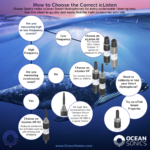The International Maritime Organization recently hosted a workshop that explored the relationship between greenhouse gas emissions (GHG) and underwater radiated noise (URN) from ships and the opportunities to reduce them. This event brought together experts in the maritime industry, environmental organizations, and governmental bodies, all in the hopes of shedding light on the critical issue of ocean noise pollution.
After two days of listening in, here are some key takeaways from this workshop:
1. Progress is being made to mitigate URN
By the year 2050, at least 50% of GHG emissions from shipping will be reduced — as mandated by the IMO. At the same time, the IMO has recognized underwater radiated noise (URN) from shipping as an unseen issue and must also be reduced. For years we’ve seen underwater noise levels rise due to shipping. However, due to its invisible nature and the challenges of measuring it, ocean noise has not been prioritized or even named as an issue.
Until now…
The IMO not only publicly recognized its impact but also shared a correlation between reducing GHG and reducing URN in tandem. This event explored the opportunities to continue to identify what GHG reduction strategies can be the most impactful for URN reduction.
The workshop highlighted a number of impressive new developments that impact propulsion efficiency and GHG emissions. Many are suitable for retrofits of existing vessels. Now, owners must look at the cost versus the benefit of these changes.
As one speaker noted, ‘time is of the essence’. Should ship owners wait for regulation changes? Or should they look now at what can be done to reduce the GHG and noise footprint of the industry?
2. Alignment is needed on how to address GHG & URN
The workshop revealed a diversity of opinions regarding the approach to addressing greenhouse gas emissions (GHG) and URN simultaneously. For example, some champion the view that all future shipping will be zero carbon and emission-free, and the challenge lies in charting the best course toward this goal.
Others advocate patience to wait for the publication and validation of standards and best practices. Here, the IMO has been actively developing regulations and guidelines to combat underwater radiated noise from ships, providing the much-needed beacon for the maritime community to navigate the waters of noise reduction.
3. Data sharing is our largest barrier
One significant opportunity in our pursuit of quieter seas became very clear during this workshop – the need for more field validation to substantiate models and tank tests. To achieve this, we must make acoustic monitoring of vessels in motion more accessible.
What can be done to make this data collection easier to perform and more affordable?
Start sharing the data. Data sharing is key so that regulators and owners can more quickly adopt best practices.
4. Developing nations cannot be overlooked
Developing nations often have fewer resources to tackle urgent environmental issues. Initiatives like GloNoise are emerging as powerful equalizers, ensuring that these nations’ views are well represented and they have an equitable stake in noise reduction efforts, effectively levelling the playing field with wealthier countries.
5. Real-world research is still needed
Collaboration and research emerged as crucial factors in addressing the issue of underwater radiated noise effectively. The workshop emphasized the importance of involving all stakeholders, including shipowners, regulators, environmental organizations, and researchers, in collaborative efforts to reduce noise pollution. Currently, tests are being done in tanks, but it will be the real-world trials that show where the true results lie.
It is clear that the maritime industry must urgently take decisive actions to make ships quieter and more energy-efficient. By doing so, we can help protect marine ecosystems, preserve biodiversity, and create a more sustainable future for our oceans. The workshop served as a significant step towards achieving these goals, and it is now up to the industry and its stakeholders to turn these takeaways into concrete actions that benefit both the environment and the maritime sector.


